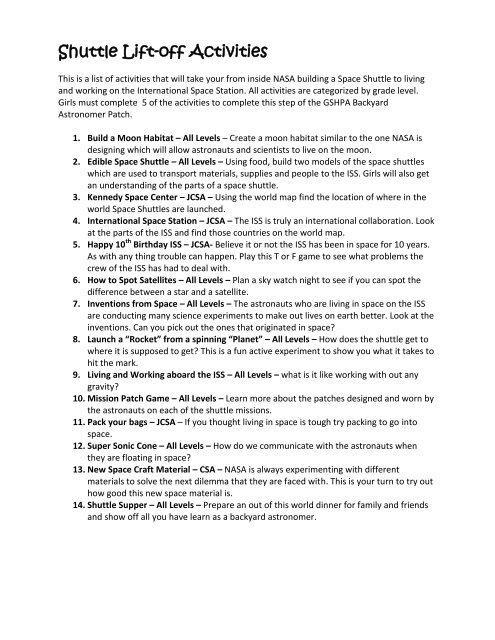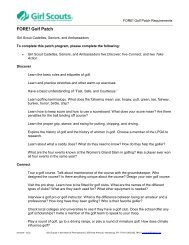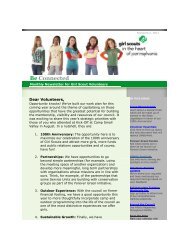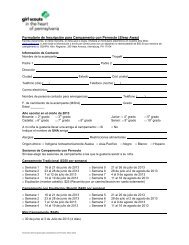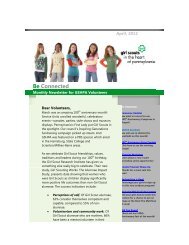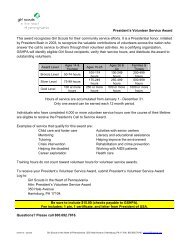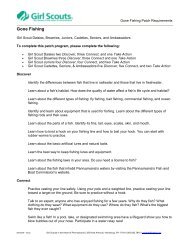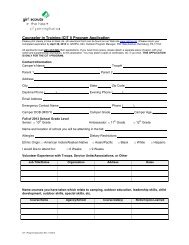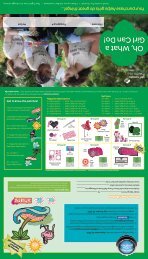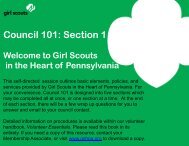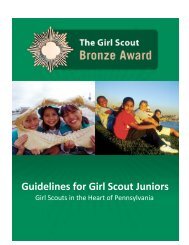Space Shuttle Lift Off Activities
Space Shuttle Lift Off Activities
Space Shuttle Lift Off Activities
Create successful ePaper yourself
Turn your PDF publications into a flip-book with our unique Google optimized e-Paper software.
<strong>Shuttle</strong> <strong>Lift</strong>-off <strong>Activities</strong><br />
This is a list of activities that will take your from inside NASA building a <strong>Space</strong> <strong>Shuttle</strong> to living<br />
and working on the International <strong>Space</strong> Station. All activities are categorized by grade level.<br />
Girls must complete 5 of the activities to complete this step of the GSHPA Backyard<br />
Astronomer Patch.<br />
1. Build a Moon Habitat – All Levels – Create a moon habitat similar to the one NASA is<br />
designing which will allow astronauts and scientists to live on the moon.<br />
2. Edible <strong>Space</strong> <strong>Shuttle</strong> – All Levels – Using food, build two models of the space shuttles<br />
which are used to transport materials, supplies and people to the ISS. Girls will also get<br />
an understanding of the parts of a space shuttle.<br />
3. Kennedy <strong>Space</strong> Center – JCSA – Using the world map find the location of where in the<br />
world <strong>Space</strong> <strong>Shuttle</strong>s are launched.<br />
4. International <strong>Space</strong> Station – JCSA – The ISS is truly an international collaboration. Look<br />
at the parts of the ISS and find those countries on the world map.<br />
5. Happy 10 th Birthday ISS – JCSA- Believe it or not the ISS has been in space for 10 years.<br />
As with any thing trouble can happen. Play this T or F game to see what problems the<br />
crew of the ISS has had to deal with.<br />
6. How to Spot Satellites – All Levels – Plan a sky watch night to see if you can spot the<br />
difference between a star and a satellite.<br />
7. Inventions from <strong>Space</strong> – All Levels – The astronauts who are living in space on the ISS<br />
are conducting many science experiments to make out lives on earth better. Look at the<br />
inventions. Can you pick out the ones that originated in space?<br />
8. Launch a “Rocket” from a spinning “Planet” – All Levels – How does the shuttle get to<br />
where it is supposed to get? This is a fun active experiment to show you what it takes to<br />
hit the mark.<br />
9. Living and Working aboard the ISS – All Levels – what is it like working with out any<br />
gravity?<br />
10. Mission Patch Game – All Levels – Learn more about the patches designed and worn by<br />
the astronauts on each of the shuttle missions.<br />
11. Pack your bags – JCSA – If you thought living in space is tough try packing to go into<br />
space.<br />
12. Super Sonic Cone – All Levels – How do we communicate with the astronauts when<br />
they are floating in space?<br />
13. New <strong>Space</strong> Craft Material – CSA – NASA is always experimenting with different<br />
materials to solve the next dilemma that they are faced with. This is your turn to try out<br />
how good this new space material is.<br />
14. <strong>Shuttle</strong> Supper – All Levels – Prepare an out of this world dinner for family and friends<br />
and show off all you have learn as a backyard astronomer.
Build a Moon Habitat!<br />
NASA wants to send humans back to the Moon!<br />
No human has walked on the Moon since the Apollo 17 mission in<br />
December 1972. This time, though, the astronauts will stay much<br />
longer than the few days of the Apollo 17 mission. So now, NASA's<br />
Exploration Technology Development Program is working on<br />
everything that will be needed to make the Moon a place where a<br />
crew of astronauts can live for months.<br />
Explorers from Earth will have to build their own habitat, or home.<br />
Their home must protect them like no home on Earth would ever<br />
need to do. Why?<br />
There is no air on the Moon. And the temperature varies from 387<br />
degrees Fahrenheit BELOW zero at night to 253 degrees Fahrenheit<br />
ABOVE zero in the day. Tiny micro-meteoroids (space rocks) rain<br />
down on the Moon's surface. And no atmosphere means no<br />
protection from the Sun's harsh radiation.<br />
So a Moon habitat for humans will have to be very tough and very sturdy. It will have to be air tight, so the inside<br />
can be pumped up with breathable air without exploding or leaking. The habitat will have to be cooled during the<br />
Moon day and heated during the Moon night. It will need a water recycling system, a power generating system,<br />
and food storage and preparation facilities.<br />
The materials to build the Moon habitat should be lightweight, since they will have to be boosted out of Earth’s<br />
gravitational field using rockets. The habitat will have to be sent to the Moon in pieces and assembled by the<br />
explorers once they arrive. So it should be easy to put together, since the Moon explorers will be working in space<br />
suits.<br />
NASA's Exploration Technology<br />
Development Program is working<br />
on designs for a Moon habitat.<br />
The light-weight experimental<br />
house shown here is inflatable,<br />
so would not take up much space<br />
until needed.<br />
As with any Moon habitat, it must have an airlock. The airlock is a small room between the door to the outside<br />
and the door to the inside. Both doors must close very tight and not leak any air. Before the astronaut opens the<br />
outside door, the inside door must be closed. The astronaut enters the airlock and closes the outside door. Then<br />
the airlock is pumped full of air. Only then can the astronaut open the inside door to enter the habitat. Leaving the<br />
habitat, the astronaut (in a spacesuit, of course), steps into the airlock with the outside door closed. The inside<br />
door is then closed and all the air pumped out of the airlock, making it a vacuum, just like the outside. The<br />
astronaut opens the outside door and steps outside.<br />
You can be a Moon explorer too. Practice by building your own Moon habitat. Pretend you are an astronaut<br />
working with your teammates on the Moon to build your new home.
Materials you will need to build one Moon habitat:<br />
148 sheets of newspaper (use a paper with large pages—tabloid size is<br />
too small—and use the full rectangular spread)<br />
Pencil<br />
Masking or packaging tape<br />
Scissors<br />
Yardstick<br />
Stapler (heavy-duty, if available)<br />
Bed sheet, colored tissue paper, or more newspapers for "walls" (optional)<br />
White glue or glue stick (optional)<br />
Construct the Moon habitat:<br />
1. Use four sheets of newspaper to build each log. Lay the sheets out flat, one on top of the other.<br />
2. Set the pencil in the corner and roll across on the diagonal. Use the pencil to help you get started, and<br />
then remove the pencil. Roll evenly, but don’t try to make the logs as thin as the pencil. When you get to<br />
the opposite corner of the paper, you’ll have a tube or log. Tape the log shut. Repeat this process until<br />
you have 37 logs. Then trim the ends a bit, making sure all the logs are the same length. They will be<br />
around 30 inches long.<br />
Now you will need a big, open space in which to construct the habitat.<br />
3. Staple three logs together to create a triangle. Repeat until you have five triangles.<br />
4. Staple the five triangles to each other at their bottom corners. Add connecting logs across the top.<br />
5. Staple the remaining five logs together at the center to make a star.<br />
6. Then raise the five connected triangles, or walls, off the floor and staple the ends together to form a fivesided<br />
(pentagonal) structure. It helps to have one person hold up the walls while another person staples.<br />
7. Now staple the free ends of the star to the junctions of the triangles on the top of the base, and the<br />
structure will stand by itself.<br />
Construct the “airlock:”
8. You should have 12 logs left. These will make the “airlock.” Staple three logs together to make another<br />
triangle (red in above drawing). Use two more logs (green) to attach the base of this triangle to one of the<br />
base logs of the “habitat.” This triangle becomes the airlock door.<br />
9. Using three more logs (blue), create a square by stapling them around the “door.” The side logs will be a<br />
bit too long, so cut them off to make a square.<br />
10. Use two more logs (yellow) to make a triangle to support the airlock at the top. To do this, staple the ends<br />
to the two top corners of the square and staple the other ends together where the triangles meet on the<br />
habitat.<br />
11. Use the last two logs (purple) to stabilize the airlock as shown in the drawing.<br />
Fill in with solid walls (optional):<br />
12. You can give the structure “solid” walls by either carefully draping a sheet or two over it or by covering<br />
each section with tissue paper or newspaper. To do this, smear glue onto the logs and gently press pieces<br />
of colored tissue paper or newspaper onto the triangles. Don’t forget to leave a door! You can rip or cut<br />
off the loose edges of the tissue paper.<br />
Optional Larger Version:<br />
You can also build a larger version of the Moon habitat. Although large enough for a child to stand up in, it may not<br />
be as strong as the smaller version. For that reason, we suggest using 5 or 6 sheets of newspaper per log.<br />
You will need 444 sheets of newspaper. Make 74 logs using 6 sheets for each log. Use two logs to make one longer<br />
log by sliding the end of one log into another and taping them together. Then trim the ends. Your logs will be<br />
about 56 inches long.<br />
Assemble the habitat as for the smaller version. Note that you will probably need a large outdoor space to<br />
assemble the triangles for Step 4.<br />
Edible <strong>Space</strong> <strong>Shuttle</strong>s both present and future.<br />
NASA is retiring the <strong>Space</strong> <strong>Shuttle</strong> around 2010. However, it needs a new way to “<strong>Shuttle</strong>” astronauts back and<br />
forth between Earth and the International <strong>Space</strong> Station – and the Moon – and eventually, Mars! NASA’s new<br />
spacecraft – the Ares Launch Vehicle, and the Orion Crew Vehicle will get crew and cargo to the space station.<br />
Orion will be able to rendezvous with a lunar landing module and an Earth departure stage in low-Earth orbit to<br />
carry crews to the moon and, one day, to Mars-bound vehicles.<br />
Like the <strong>Space</strong> <strong>Shuttle</strong> Atlantis, the Ares Launch Vehicle and the Orion Crew Vehicle are comprised of several parts.<br />
The three main components of it are the orbiter which houses the crew members; a large external tank which<br />
holds the fuel for the main J2 engines; and two solid rocket boosters which give the <strong>Shuttle</strong> its lift during the first<br />
two minutes of flight.<br />
This activity will allow you to learn the differences between the space shuttles by building an edible one!<br />
What You Need (per girl or group):<br />
• 2 Twinkie (External Tank)<br />
• 1 1/2 Swiss Roll (Orbiter)<br />
• 1 Marshmallow (J2 Engine)<br />
• 4 Hershey’s Kiss (Nose Cap)<br />
• 4 mini marshmallows<br />
• 2 tortilla chips<br />
• 3 Pirouline – 1 broken in half (Solid Rocket Boosters)<br />
• Marshmallow Cream<br />
• Paper towel<br />
• Plastic spoon and knife<br />
• Wet Wipes!<br />
• Image of the <strong>Space</strong> <strong>Shuttle</strong> Atlantis and Ares Launch Vehicle w/Orion Crew Vehicle (below)
What To Do:<br />
Atlantis <strong>Space</strong> <strong>Shuttle</strong><br />
Using marshmallow cream “glue” a Pirouline to each vertical side of the Twinkie. The piroulines are the solid rocket<br />
boosters and the Twinkie is the fuel tank. Attached, using the same “glue” attach the Swiss Roll to the top (not<br />
end) of the Twinkie. Place a tortilla chip on both of the bottom sides of the Swiss Roll to resemble wings. (Place to<br />
form a right angle against the Swiss Roll) “Glue” the mini marshmallows to the bottom of the Swiss Roll. “Glue” a<br />
Hershey’s kiss to the top of the Swiss Roll for the nose cone. Now you’ve got yourself an Edible Atlantis <strong>Space</strong><br />
<strong>Shuttle</strong>.<br />
Ares Launch Vehicle w/ Orion Crew Vehicle (tip: everything gets attached in a straight line)<br />
Using the Marshmallow cream, “glue” together two Piroulines for the rocket booster. Attach a Twinkie to one end<br />
of the piroulines using marshmallow cream. The Twinkie is the fuel tank. Add a marshmallow to the other end of<br />
the Twinkie for the engine. Cut a Swiss roll in half. Add the Swiss roll to the end of the marshmallow. Add a<br />
Hershey’s Kiss to the top for the Launch Abort System. Now you’ve got yourself an Edible Ares Launch Vehicle w/<br />
Orion Crew Vehicle.<br />
Compare the two vehicles and discuss difference and similarities before you enjoy this delicious snack.<br />
What are the main components of the <strong>Space</strong> <strong>Shuttle</strong>?<br />
(External Tank, Solid Rocket Boosters, and the Orbiter)<br />
What is different about the new <strong>Space</strong> <strong>Shuttle</strong> design?<br />
(The new design doesn’t have a winged <strong>Shuttle</strong> on the side of the external tank.)<br />
<strong>Space</strong> <strong>Shuttle</strong> Atlantis<br />
Ares I w/ Orion
Kennedy <strong>Space</strong> Center<br />
On July 29, 1958, President Dwight D. Eisenhower signed Public Law 85-568, creating the National Aeronautics and<br />
<strong>Space</strong> Administration, also known as NASA. In July 1962, the agency established its Launch Operations Center on<br />
Florida's east coast, and renamed it in late 1963 to honor the president who put America on the path to the moon<br />
– President John F. Kennedy.<br />
NASA's John F. Kennedy <strong>Space</strong> Center has helped set the stage for America's adventure in space for more than four<br />
decades. The spaceport has served as the departure gate for every American manned mission and hundreds of<br />
advanced scientific spacecraft. From the early days of Project Mercury to the space shuttle and International <strong>Space</strong><br />
Station, from the Hubble <strong>Space</strong> Telescope to the Mars Exploration Rovers, the center enjoys a rich heritage in its<br />
vital role as NASA's processing and launch center. As the nation embarks on a new chapter in space exploration,<br />
Kennedy will continue to make history.<br />
Oct. 1, 2009 marks the 50th Anniversary of NASA, as it was on this date in 1958 that the National Aeronautics and<br />
<strong>Space</strong> Administration (NASA) began operations. Over the past 50 years, the employees of America's space program<br />
have been at the forefront of many incredible accomplishments.<br />
Kennedy <strong>Space</strong> Center has a rich history in the space program, having been named an independent NASA<br />
installation in 1962. From the historic launch pads in Florida, missions of discovery have been launched.<br />
Launching from Both U.S. Coasts<br />
Primary launch sites for NASA's shuttles are;<br />
Cape Canaveral Air Force Station, Fla.,<br />
Vandenberg Air Force Base, Calif.<br />
additional launch locations<br />
NASA's Wallops Island, Va., flight facility,<br />
Kwajalein Atoll in the Republic of the Marshall Islands in the North Pacific,<br />
Kodiak Island, Alaska.<br />
Activity<br />
Find the above locations on a world map and place a marker.<br />
Which location would you like to visit to see a shuttle launch? Why?<br />
International <strong>Space</strong> Station (ISS)<br />
In 1984, President Ronald Reagan proposed that NASA build a space station, but costs were so high that funds<br />
were unavailable for the station. Therefore, in 1993, President Bill Clinton directed NASA to redesign the proposed<br />
station by reducing the cost and time it will take to be completed. Keeping the cost and time in mind, NASA began<br />
to explore how they could make this enormous human space station become a reality. The United States was not<br />
the only country interested in constructing a large, long- lasting human space station. Russia also had high hopes of<br />
engineering a station, but funds were tight. As several countries around the world kept expanding their space<br />
programs, NASA began to consider the plans for an internationally owned space station. With several discussions<br />
and meetings, the plans for an international space station were finally made. Sixteen different countries would<br />
participate in the construction and finance of this Earth satellite. The main suppliers would be Russia and the<br />
United States. Russia wanted to launch and control half of the space station, so due to this, the International <strong>Space</strong><br />
Station (ISS) is divided into two parts. Russia controls one-half of the station, and the U. S. controls 75% of the<br />
other half. Along with the U.S. and Russia, Japan, Canada, Brazil, and eleven countries in the European <strong>Space</strong>
Agency (ESA) own some part of the ISS. The eleven countries in the ESA are Belgium, Denmark, France, Germany,<br />
Italy, the Netherlands, Norway, Spain, Sweden, Switzerland, and the United Kingdom. The ISS is a $48 billion space<br />
construction project that is to be completed over 5 years and will weigh one million pounds. The first component,<br />
Zarya, which is a control module designed for propulsion and power, was launched in 1998. Shortly after that, the<br />
shuttle Endeavour carried the module Unity, a connecting passageway to living and working areas, into orbit and<br />
docked it with Zarya. In 2000, the first crew consisting of one American astronaut and two Russian cosmonauts<br />
moved into the ISS. When the International <strong>Space</strong> Station is complete, it will have a mass of almost 1 million<br />
pounds, be larger than a five-bedroom house and measure 361 feet end-to-end. 2010 marks the end of the space<br />
shuttle program to deliver supplies to the <strong>Space</strong> Station and it is projected that by 2015 the ISS will no longer be in<br />
operation.<br />
Activity<br />
On the world map, find all the countries that are international partners in the ISS.<br />
Look at the picture of the ISS components. Which countries supplied which parts of the ISS?
Happy 10 th Birthday ISS<br />
10 Headaches and Near-Mishaps on the International <strong>Space</strong> Station<br />
Ten years ago, on Nov. 20, 1998, a Russian rocket launched the functional cargo block, the first piece of the station, into space. Since<br />
then, this mostly complete orbiting laboratory has been the site of research into subjects such as the effects of weightlessness on<br />
humans and animals, but it has also seen its share of mishaps. That's only natural—keeping an orbiting space station constantly<br />
operational and inhabited is a laborious task filled with pitfalls, and the ISS's direct predecessor, Russia's Mir, became notorious for<br />
its technical difficulties. Below are some of the headaches, mishaps and near-misses the ISS may have had to confront in its 10 years<br />
of existence. Choose the ones you think are true.<br />
The International <strong>Space</strong> Station as captured by the crew of STS-124 aboard <strong>Space</strong> <strong>Shuttle</strong> Discovery on June 11, 2008. (Photograph<br />
by NASA)<br />
______ 1.<br />
The ISS had two spiders on the station so that scientists could see<br />
whether they could spin webs without gravity. One struggled, building a tangled web. The other... went missing. Crew<br />
members said they were looking for it, but concluded that it had probably just snuck off into a dark corner of the<br />
station and starting weaving its web.<br />
______ 2.<br />
______ 3.<br />
______ 4.<br />
______ 5.<br />
______ 6.<br />
______ 7.<br />
______ 8.<br />
______ 9.<br />
<strong>Space</strong> Debris damaged the solar rotary joints which keep the solar panels pointed at the sun. The ISS was capable of<br />
working with just one.<br />
While repairing the ISS during a routine space walk, Heidi Stefanyshyn-Piper dropped her tools and they floated<br />
away.<br />
The ISS’s only toilet broke. A pump wore out and the toilet was unusable.<br />
Broken Solar Panels<br />
The ISS needs only one of three Russian-built computer systems to operate its thrusters and control the position of<br />
the station. All three computers crashed at the same time.<br />
The flight engineer noticed a funny smell, like that of a rubber gasket burning, and the fire alarm went off in the<br />
cabin.<br />
The crew of two Russians and one American flying up to the ISS in 2004 were eager to arrive and replace the<br />
previous crew. They were driving too fast and crashed into the ISS.<br />
<strong>Shuttle</strong> Service is the only way to get needed materials to the ISS. All the space shuttles are currently scheduled for<br />
retirement in 2010 leaving the ISS with no way to get materials for 5 years.
How to Spot Satellites<br />
If you go out and carefully study the sky near dusk or dawn, and you have relatively dark skies, the odds are that you should not<br />
have to wait more than 15 minutes before you see one of the more than 35,000 satellites now in orbit around Earth.<br />
Most of these "satellites" are actually just "space junk" ranging in size from as large as 30 feet, down to about the size of a softball.<br />
Most satellites -- especially the bits of debris -- are too faint to be seen with the unaided eye. But several hundred can be spotted<br />
with the unaided eye. These are the satellites that are large enough (typically more than 20 feet in length) and low enough (100 to<br />
400 miles above Earth) to be most readily seen as sunlight reflects off of them.<br />
The biggest<br />
The International <strong>Space</strong> Station (ISS) is by far the biggest and brightest of all the man-made objects orbiting the Earth. (satellite)<br />
Presently circling the Earth at an average altitude of 216 mi and at a speed of 17,200 mi per hour, it completes 15.7 orbits per day<br />
and it can appear to move as fast as a high-flying jet airliner, sometimes taking about four to five minutes to cross the sky. Because<br />
of its size and configuration of highly reflective solar panels, the space station is now, by far, the brightest man-made object<br />
currently in orbit around the Earth.<br />
On favorable passes, it can appear as bright as the planet Venus and some 16 times brighter than Sirius, the brightest star in the<br />
night sky.<br />
And as a bonus, sunlight glinting directly off the solar panels can sometimes make the ISS appear to briefly "flare".<br />
Viewing opportunities<br />
From October through the final days of July, North Americans and Europeans will have many opportunities to see the ISS flying over<br />
their homes, due chiefly to a seasonal circumstance.<br />
Nights are now the shortest and the time that a satellite in a low-Earth-orbit (like the ISS) can remain illuminated by the Sun can<br />
extend throughout the night, a situation that can never be attained during other times of the year. Because the ISS circles the Earth<br />
about every 90 minutes on average, this means that it's possible to see it not just on one singular pass, but for several consecutive<br />
passes.<br />
Moreover, because the ISS revolves around the Earth in an orbit that is inclined 51.6-degrees to the equator, there are two types of<br />
passes that are visible.<br />
In the first case (we'll call it a "Type I" pass), the ISS initially appears over toward the southwestern part of the sky and then sweeps<br />
over toward the northeast.<br />
About seven or eight hours later, it becomes possible to see a second type of pass (we'll call it "Type II"), but this time with the ISS<br />
initially appearing over toward the northwestern part of the sky and sweeping over toward the southeast.<br />
Type I passes will initially be visible in the morning hours, prior to sunrise. By early July, Type I passes will be visible during the<br />
evening hours, just after sunset, while Type II passes will be occurring in the early morning. By late July, visibility of the Type II passes<br />
will have shifted into the evening hours.<br />
When and where to look<br />
So what is the viewing schedule for your particular hometown? You can easily find out by visiting the below web site:<br />
NASA's SkyWatch<br />
Enter your zip code or city for a list of suggested spotting times. Predictions computed a few days ahead of time are usually accurate<br />
within a few minutes. However, they can change due to the slow decay of the space station's orbit and periodic reboosts to higher<br />
altitudes. Check frequently for updates.<br />
Activity<br />
Find out the best time to view the ISS and plan a night out under the stars. Did you see it?
Inventions from <strong>Space</strong><br />
The items below are used in everyday life on Earth. Which ones were created with technology from the NASA space program and<br />
experiments conducted on the International <strong>Space</strong> Museum (ISS)? Mark a T or F in the box before the item.<br />
TV Satellite Dish<br />
Pens<br />
Medical Imaging<br />
Shock Absorbing Helmets<br />
Vision Screening System<br />
Ski Boots<br />
Ear Thermometer<br />
Failsafe Flashlight<br />
Curling Iron<br />
Invisible Braces<br />
Smoke Detector<br />
Edible Toothpaste<br />
Sun Tiger Glasses<br />
Dishes<br />
Automobile Design Tools<br />
Advanced Plastics<br />
Water Bottle<br />
Cordless Tools<br />
Aerodynamic Bicycle Wheel<br />
Fire Fighter Equipment<br />
Thermal Gloves and Boots<br />
Joystick Controllers
Inventions from <strong>Space</strong> - Answer Sheet<br />
The items below all use technologies or materials that were originally developed for the space program. Check your answers above to<br />
see if you guessed correctly.<br />
TV Satellite Dish<br />
NASA developed ways to correct errors in the signals coming from the spacecraft. This<br />
technology is used to reduce noise (that is, messed up picture or sound) in TV signals coming<br />
from satellites.<br />
Medical Imaging<br />
NASA developed ways to process signals from spacecraft to produce clearer images. (See<br />
more on digital information and how spacecraft send images from space.) This technology<br />
also makes possible these photo-like images of our insides.<br />
Vision Screening System<br />
Uses techniques developed for processing space pictures to examine eyes of children and<br />
find out quickly if they have any vision problems. The child doesn't have to say a word!<br />
Ear Thermometer<br />
Instead of measuring temperature using a column of mercury (which expands as it heats up),<br />
this thermometer has a lens like a camera and detects infrared energy, which we feel as<br />
heat. The warmer something is (like your body), the more infrared energy it puts out. This<br />
technology was originally developed to detect the birth of stars.<br />
Fire Fighter Equipment<br />
Fire fighters wear suits made of fire resistant fabric developed for use in space suits.<br />
Smoke Detector<br />
First used in the Earth orbiting space station called Skylab (launched back in 1973) to help<br />
detect any toxic vapors. Now used in most homes and other buildings to warn people of fire.<br />
Sun Tiger Glasses<br />
From research done on materials to protect the eyes of welders working on spacecraft,<br />
protective lenses were developed that block almost all the wavelengths of radiation that<br />
might harm the eyes, while letting through all the useful wavelengths that let us see.<br />
Automobile Design Tools<br />
A computer program developed by NASA to analyze a spacecraft or airplane design and<br />
predict how parts will perform is now used to help design automobiles. This kind of software<br />
can save car makers a lot of money by letting them see how well a design will work even<br />
before they build a prototype.<br />
Cordless Tools<br />
Portable, self-contained power tools were originally developed to help Apollo astronauts drill<br />
for moon samples. This technology has lead to development of such tools as the cordless<br />
vacuum cleaner, power drill, shrub trimmers, and grass shears.<br />
Aerodynamic Bicycle Wheel<br />
A special bike wheel uses NASA research in airfoils (wings) and design software developed for<br />
the space program. The three spokes on the wheel act like wings, making the bicycle very<br />
efficient for racing.
Thermal Gloves and Boots<br />
These gloves and boots have heating elements that run on rechargeable batteries worn on<br />
the inside wrist of the gloves or embedded in the sole of the ski boot. This technology was<br />
adapted from a spacesuit design for the Apollo astronauts.<br />
<strong>Space</strong> Pens<br />
The Fisher <strong>Space</strong> Pen was developed for use in space. Most pens depend on gravity to make<br />
the ink flow into the ball point. For this space pen, the ink cartridge contains pressured gas to<br />
push the ink toward the ball point. That means, you can lie in bed and write upside down<br />
with this pen! Also, it uses a special ink that works in very hot and very cold environments.<br />
Shock Absorbing Helmets<br />
These special football helmets use a padding of Temper Foam, a shock absorbing material<br />
first developed for use in aircraft seats. These helmets have three times the shock absorbing<br />
ability of previous types.<br />
Ski Boots<br />
These ski boots use accordion-like folds, similar to the design of space suits, to allow the boot<br />
to flex without distortion, yet still give support and control for precision skiing.<br />
Failsafe Flashlight<br />
This flashlight uses NASA's concept of system redundancy, which is always having a backup<br />
for the parts of the spacecraft with the most important jobs. This flashlight has an extrabright<br />
primary bulb and an independent backup system that has its own separate lithium<br />
battery (also a NASA developed technology) and its own bulb.<br />
Invisible Braces<br />
These teeth-straightening braces use brackets that are made of a nearly invisible translucent<br />
(almost see-through) ceramic material. This material is a spinoff of NASA's advanced ceramic<br />
research to develop new, tough materials for spacecraft and aircraft.<br />
Edible Toothpaste<br />
This is a special foamless toothpaste developed for the astronauts to use in space (where<br />
spitting is not a very good idea!) Although this would be a great first toothpaste for small<br />
children, it is no longer available.<br />
Joystick Controllers<br />
Joystick controllers are used for lots of things now, including computer games and vehicles<br />
for people with disabilities. These devices evolved from research to develop a controller for<br />
the Apollo Lunar Rover, and from other NASA research into how humans actually operate<br />
(called "human factors").<br />
Advanced Plastics<br />
<strong>Space</strong>craft and other electronics need very special, low-cost materials as the base for printed<br />
circuits (like those inside your computer). Some of these "liquid crystal polymers" have<br />
turned out to be very good, low-cost materials for making containers for foods and<br />
beverages.
Launch a "Rocket" from a Spinning "Planet"<br />
How do space engineers know when to launch a rocket and shuttle?<br />
Well, nothing in space stands still. Everything either orbits around something else, or moves toward or away from something else. So<br />
how do space engineers aim a spacecraft so it lands on Mars or meets up with a particular comet or asteroid? Not only are Earth and<br />
the target constantly moving in their different orbits around the Sun, but our Earthly launch pad is spinning at about 1,000 miles per<br />
hour when we launch the rocket!<br />
Activity<br />
If you don't think this is a hard problem, try this:<br />
• Gather up whatever small balls you have. They can be tennis balls, softballs, whiffle balls, golf balls, or bean bags. Or<br />
you can make small "paper basketballs" by tightly wadding up pieces of notebook-sized paper.<br />
• Put the balls in a bucket or bag to make them easy to carry.<br />
• Find another empty container like a bucket or wastebasket or laundry basket to be the "basket."<br />
• Take the paper balls (in their container) and the basket to the nearest park or playground that has a merry-go-round.<br />
(Not the kind with horses, but the kind you push around then hop on and ride.) OR use two “sit ‘n spin” toys.<br />
• Place the basket on the ground about 9 to 12 feet from the merry-go-round/“sit ’n spin”. Then, step up on the merrygo-round<br />
or sit on the sit ‘n spin with your container of balls.<br />
• Without moving, try tossing a few balls into the basket on the ground.<br />
• Now, have a partner start to spin you going slowly.<br />
• Try tossing the balls into the basket on the ground as you go around.<br />
Adding the motion makes it a lot harder to hit your target, doesn't it? Now imagine the target is<br />
on another spinning merry-go-round on the other side of the playground. If you are using the<br />
sit ’n spin place the empty bucket on the second sit ‘n spin and turn it the opposite direction<br />
you are going. Even if your paper balls were real basketballs or baseballs, you'd have a lot of<br />
trouble.<br />
What you will probably find out is that Timing is everything!<br />
In picking a time to launch, space engineers and scientists have to consider quite a number of<br />
things. Most of them have to do with getting the biggest boost possible from the big launch<br />
pad called planet Earth!<br />
Earth goes around the sun at a brisk 66,000 miles per hour! If our interplanetary spacecraft is<br />
aimed in the same direction Earth is already going, it will get a big head start.<br />
Also, Earth rotates eastward on its axis, one complete turn each day. At the equator, Earth's<br />
surface is rotating at 1041 miles per hour!<br />
So if we launch the rocket toward the east, it will get another big boost from<br />
Earth's rotational motion.<br />
Now, we launch eastward. We pick the time of launch to give the rocket<br />
time to accelerate as it goes partway around Earth. Then, when the<br />
spacecraft is headed in the same direction as Earth's orbital motion around<br />
the sun, the rocket gives it a final boost out of Earth’s orbit and on its way.<br />
Using both the rotational motion of Earth on its axis and the orbital motion<br />
of Earth around the Sun, we can save a lot of fuel and a lot of time in getting<br />
to our far distant destination!
Living and Working Aboard the ISS<br />
Sleeping in space is quite different from sleeping on Earth. Instead of a bed, you have a wall-mounted sleeping bag that you slip<br />
into and zip up. The bag is also equipped with arm restraints to prevent your arms from floating above your head while you<br />
sleep.<br />
While stations such as Skylab and Mir have been equipped with a shower, most astronauts take sponge baths using washcloths<br />
or moistened towelettes. This reduces the amount of water consumed. Each astronaut also has a personal hygiene kit with<br />
a toothbrush, toothpaste, shampoo, razor and other basic toiletries.<br />
The food on the ISS is mainly frozen, dehydrated or heat-stabilized, and drinks are dehydrated. Astronauts collect food trays and<br />
utensils, locate their individually-packaged meal from a storage compartment, prepare the items (rehydrate if necessary),<br />
heat the items (microwave, forced-air convection oven), place them in the tray and eat. After the meal, they will place the<br />
used items in a trash compactor, and clean and stow the utensils and trays. Interestingly, astronauts get to select their<br />
menus approximately five months before their flight.<br />
In weightless conditions, the body loses bone and muscle mass. To counter these losses, astronauts exercise daily. The service<br />
module is equipped with a treadmill and a stationary bicycle. Astronauts must strap themselves onto these devices so that<br />
they do not float away while exercising.<br />
Activity<br />
Pretend you are doing your homework at the kitchen table in your house. All of a sudden there is no gravity. What happens? How<br />
will you do your homework? What modifications have to be made to the furniture, books, etc. to be able to complete your<br />
homework?
Mission Patch Games<br />
Similar to Girl Scouts NASA creates a patch for each mission. Each patch has special meaning to the crew and is given to the crew,<br />
families, and NASA employees.<br />
Below are several games you can play with the NASA patches. Patches are located at the end of this document.<br />
In preparation, cut out the patches and description pages.<br />
Race to the ISS<br />
Divide into 2 teams. Divide patches and descriptions in 2 equal piles of 11. Tape or tack either the descriptions or the patch design to<br />
a wall. Distribute what you didn’t tape to the wall to the team members. Each team will race to the wall and try to match the patch<br />
with the mission by taping it next to the correct image. When all are complete, play stops and the leader checks to see if correct.<br />
Leader will tell team how many are wrong not which ones are wrong. If images need to be corrected play will resume again. If<br />
images are correct that team wins.<br />
(Hint: learn how to read Roman Numerals below)<br />
Astronauts Stick Together<br />
In space if you don’t trust the people you are with it will be a very long, hard mission. You have been separated from your partner<br />
while on a space walk to repair the solar shield. You must find your partner before your air runs out.<br />
Shuffle all cards. Hand out one card to each person. When time starts all must find their partner and sit down. Time limit is 1 minute.<br />
Once you have found your partner, learn out the mission you are on and share with the others.<br />
Who Went First?<br />
Cut out cards keeping descriptions connected to image. Hand out a mission to each girl. The goal of this game is to put the missions<br />
in chronological order without talking.<br />
Design Your Own Mission Patch<br />
You have just graduated from NASA Aeronautical program and will be going on your first mission. They have asked you to design the<br />
mission patch. Using a plain piece of paper, decide; What is this mission number? Where are you going? Are you honoring any one<br />
special?<br />
Are people from other country’s or planets joining you? The answers to these questions will help you create the patch. Now create<br />
the patch!<br />
Roman Numeral Tutorial<br />
Symbol Value<br />
I<br />
V<br />
X<br />
L<br />
C<br />
D<br />
1(one)<br />
5(five)<br />
10 (ten)<br />
50 (fifty)<br />
100 (one hundred)<br />
500 (five Hundred)<br />
M 1000 (one thousand)<br />
Numbers 1-10<br />
I<br />
II = 1 + 1<br />
III = 1 +1+1<br />
IV = 5 - 1<br />
V<br />
VI = 5 + 1<br />
VII = 5 + 1+1<br />
VIII = 5 +1+1+1<br />
IX = 10 -1<br />
X<br />
More examples<br />
13 - XIII = 10 +1+1+1<br />
14 – XIV = 10+5-1<br />
21 – XXI = 10+10 +1<br />
24 – XXIV = 10+10+5-1<br />
Get it now? Okay, try some on your<br />
own.<br />
4 8 13<br />
19 22 15<br />
10 9 29<br />
30 26 2<br />
BONUS: How would you write the year in Roman Numerals __________________________<br />
How would you write the year that NASA was formed ________________________<br />
Answers: 4-IV, 8- VIII, 13-XIII, 19-XIX, 22-XXII, 15-XV, 10-X, 9-IX, 20-XXIX, 30- XXX, 26- XVI, 2-II<br />
Year- 2009 – MMI Year NASA was formed – 1962- MCMLXII
Pack Your Bags<br />
You have been selected to join the astronauts of <strong>Space</strong> <strong>Shuttle</strong> Discovery for the Mission STS-129 which will deliver space<br />
components to the International <strong>Space</strong> Station (ISS). Because this is one of the last delivery missions to the ISS there is not a lot of<br />
room left on the shuttle for your belongings. AND… you will be gone for 9 months.<br />
Your mission is to pack for your trip.<br />
Tips<br />
storage space is limited<br />
refrigeration, freezers, and cooking take up a lot of the space shuttles energy<br />
there is no gravity in space.<br />
1. From the list below you must choose;<br />
Amount of each<br />
Category<br />
Foods, drink, and snacks –<br />
5<br />
must provide you with a balanced diet.<br />
A remembrance of home –<br />
1<br />
you will be gone for 3 months.<br />
Past time activities –<br />
2<br />
you can’t just go outside for a walk.<br />
Personal entertainment –<br />
2<br />
what are you going to do in your free time?<br />
Exercise option –<br />
1<br />
you must keep your muscles working.<br />
Health care items –<br />
3<br />
space can do funny things to your body.<br />
Each item has points and a pro and con associated with it. Choose wisely.<br />
Your life and the other astronaut’s lives may depend on your choices.<br />
2. Once the bags are packed, refer to the list of items for the total overall points and decide weather you have made a good<br />
choice. Add up your/teams total points.<br />
3. Compare your teams total with the chart below to see how successful your packing was.<br />
‣ Discuss some of the choices and why they were good or not so good. What consequences would come from your choices?<br />
4. Try this again after reading all the items pro’s and con’s. Did you have a more successful trip?<br />
Points Earned<br />
Trip Results<br />
48 and above Mission Accomplished – You should be proud of yourselves<br />
38-47 Great Trip – food could have lasted longer but your mom’s home<br />
cooking will taste great when you get home<br />
28-37 Good Trip – found yourself a little bored because past time activities did<br />
not work out<br />
18 – 27 Had to return early from the trip – We got sick<br />
Below 18 Didn’t launch - cargo was to heavy
Pack Your Bags Item List<br />
Item Points Pro Con<br />
Food<br />
Orange Juice Boxes 5 Good nutrition, lasts for a while, Could take up a lot of space<br />
single serve sides<br />
Soda 0 Tastes better than water Bubbles will act like a thruster and send you<br />
flying across the room when opening a can - no<br />
nutritional value<br />
Ketchup 2 Makes food taste better Float away and make a mess in the cabin<br />
Mustard 2 Makes Food taste better Float away and make a mess in the cabin<br />
Cookies 2 Taste good, bring up employee moral Floating crumbs could be hazardous to lungs<br />
Candy bar 3 Taste good, bring up employee moral, No nutrition except sugar for energy<br />
stores well, small packaging<br />
Pizza 4 Meat, vegetables and bread in one<br />
package<br />
Needs a lot of shuttles energy to refrigerate and<br />
cook<br />
Boxed Macaroni and cheese 4 Tastes good, easy to store, no<br />
refrigeration necessary, compact<br />
Do not use powered cheese kind as this will<br />
cause lung problems and requires milk<br />
Fresh vegetables 3 Very healthy Do not last long<br />
Fresh Fruit 3 Very healthy Do not last long<br />
Hamburger 4 Complete meal in one package Uses a lot of ships energy<br />
Chips 3 Taste good does not need<br />
refrigeration<br />
Little nutrition, large package hard to store,<br />
crumbs could cause problems with lungs<br />
Tortillas 4 Nutritious, can be very versatile in Needs to be frozen to last long<br />
preparing meals, crumbles<br />
Ice cream 3 Tasty, brings up morale Needs freezer<br />
Nuts 5 Nutritious, great protein, last long Could have crumbs<br />
Past Time <strong>Activities</strong><br />
Craft supplies 3 Could use materials for needed Could be messy and hard to keep track of items<br />
projects on shuttle, small and<br />
compact<br />
Notebook and Pencil 3 Great for keeping a journal, passing<br />
time<br />
Would need a lot of paper to last the trip, could<br />
be heavy and hard to store<br />
Glue 0 Changes make-up in zero- gravity<br />
Soccer ball 1 Always fun to make up a new game Hard to store, hard to hold onto<br />
Basketball 1 Always fun to make up a new game Hard to store, hard to hold onto<br />
Crayons 3 Great for past time fun, come with Need something to use on<br />
own container, easy to store<br />
Cards 4 Great for past time fun, come with Need somehow to hold down on table<br />
own container, easy to store, can<br />
play with others<br />
Poker chips 2 Will float away<br />
Paint and paper 2 Great fun for free time Paint will change make-up in space, will be<br />
messy, paper will take up a lot of space<br />
Books 3 Great free time activity Too heavy, need a lot to last trip<br />
Remembrance of Home<br />
Teddy bear 3 Can help you feel close to home Takes up space<br />
Pictures of family 2 Can help you feel close to home Will float away, cannot put a nail into the walls<br />
of the space shuttle<br />
Personal Media<br />
Handheld electronic game 3 Good past time Need a lot of batteries which can be heavy<br />
Radio with CD and Tape 3 Good past time Need batteries, need to store CD’s and tapes, no<br />
reception for the radio, other astronauts may<br />
not like your music<br />
Laptop computer 0 Good for playing music, looking at<br />
pictures, e-mailing friends, etc.<br />
OOOppps! No internet
i-pod 3 Good past time, personal music only Need charger, use ships energy<br />
Cell phone 1 No reception<br />
CD’s 3 Good past time to listen to music Take up a lot of room, need a player also which<br />
will need batteries<br />
Video camera 4 Great for documenting your trip Need a way to recharge, take up shuttles energy,<br />
need a lot of tapes or DVD’s to shoot everything<br />
TV 0 No reception<br />
Movies 2 Good past time Need to have something to watch these on.<br />
Takes up a lot of space<br />
Tapes 2 Good past time Need to have something to use these with, take<br />
up space, not everyone will like your taste in<br />
music.<br />
Exercise<br />
Dumbbells/weights 0 Hard to store, in anti-gravity these will have no<br />
weight and do nothing for your exercise<br />
Treadmill 2 Good exercise Must be modified to work in space<br />
Exercise bike 5 Great exercise Must be bolted to floor with foot holds<br />
Yoga mat, ball and bands 3 Good exercise Must find a way to hook to floor, ball won’t work<br />
Health Care<br />
Aspirin 2 Good for helping with headaches Might not be as effective in space<br />
Band-aid 5 Keep out infections, easy to store<br />
Hair dryer 1 Uses shuttles energy<br />
Curling iron 0 Uses shuttles energy<br />
Stethoscope 5 Easy to store and use, great for<br />
helping with health concerns<br />
Toothbrush and toothpaste 5 Easy to store, paste will stick to Need a lot to last the trip<br />
brush and not float away<br />
Hair brush 5 Easy to store, does not use any<br />
energy
Have Super Hearing with a Super Sound Cone!<br />
Pick out tiny sounds your ears alone can't hear. Make a simple sound cone<br />
to turn up the volume on whatever sounds are coming from a particular direction.<br />
You will be amazed!<br />
What you need:<br />
A big piece of tag board or poster board, about 18 x 24 inches<br />
Transparent tape<br />
What to do:<br />
This is so easy! Just roll the poster board into a cone shape, leaving a small hole (about 1/2 to 1 inch across) at the pointed end.<br />
Leave the big end as wide as you can. Then tape the edge into position. Take your cone outside. Put the small end in your ear. Point<br />
the cone in different directions and listen carefully. Notice how different the world sounds with and without the cone to aid your<br />
hearing.<br />
This girl can clearly hear her big sister's<br />
watch ticking from this far away!<br />
What tiny sounds did you notice with the cone that you didn't notice before?<br />
Now, can you guess what these two objects have in common?<br />
Like waves in the ocean, sound makes waves in the air. Air jostles back and forth as the sound energy waves pass. If you put<br />
something like paper in the path of the sound wave, it will also vibrate quite a lot. If you give this paper surface the right shape, the<br />
sound waves will be funneled to a point. So your super sound cone is a sound funnel!<br />
The same sort of idea makes NASA's giant dish antennas work. These antennas listen for signals from the planetary spacecraft now<br />
exploring space far from Earth.<br />
The antenna dish in this picture is about 110 feet<br />
across. This antenna is in Australia. See how tiny the<br />
sheep look as they graze peacefully beneath its<br />
attentive ear.<br />
We can't just build a spacecraft, tell it to phone home once in a while, and then launch it to Mars or Jupiter! We must have a way to<br />
hear its tiny voice and talk to it when it is very far away.
Of course, no spacecraft actually communicates by sound. Messages wouldn't get very far, since sound waves can't travel in the<br />
vacuum of space! But the spacecraft do send out radio waves, which can travel practically forever. The trouble is, the radio waves<br />
spread out and get weaker and weaker the farther they travel.<br />
So NASA's radio wave "ears" must be very big indeed - twice as big as the one in the picture above!<br />
These dish antennas don't look much like your sound cone, do they? But the path the radio signals take once they hit the dish is like<br />
a folded up cone. Once the signal hits the focus (like the small end of your cone), electronic instruments (or your ear) take over to<br />
turn up the volume even more.<br />
Sounds Waves<br />
Sounds waves<br />
funneled<br />
to focus point<br />
Focus<br />
Point<br />
Super Sound Cone<br />
Test a New <strong>Space</strong>craft Material<br />
Being in space is not at all like being on Earth. It's usually very hot or very cold. There's no air. There's very little gravity. And the<br />
radiation is terrible!<br />
Suppose you are a very smart spacecraft engineer. You have invented a new material to use for the fuel tanks on the spacecraft. But<br />
before you send your new material into the harsh environment of space, you must test it on Earth in a space-like situation.<br />
Please get an adult to help you with this activity, because you will be heating and pouring boiling water!<br />
To test this "new material" (which you have made in the shape of a soft drink can!) you will need:<br />
An empty aluminum soft drink can<br />
A medium-sized balloon<br />
A fat rubber-band of a size to wrap once tightly around the top of the can<br />
1/4cup boiling water
Cut the top off the balloon.<br />
Twist the pop-top off the can and carefully pour the boiling water into the can.<br />
Being careful not to burn yourself on the hot can, stretch the balloon over the top of the can and secure around the rim with the<br />
rubber band. You don't want it to pop off or leak air.<br />
Now just watch.<br />
What happens first?<br />
What happens after the water inside starts to cool?<br />
Keep checking the can every few minutes until it is completely cool.<br />
Does this experiment tell you how good the material will be for making spacecraft fuel tanks?<br />
How would this material work if the spacecraft were to be dropped into the very thick and high-pressure atmosphere of a planet like<br />
Jupiter?<br />
Will this material be good for going into space?<br />
The can collapses because you have made a partial vacuum inside the can. This means the air<br />
inside the can is thinner (less dense) than the air outside the can.<br />
How did we make a vacuum?<br />
Hot air is thinner and lighter than cool air. When you seal the can, the air inside is hot. That means<br />
there are fewer molecules of air inside the can than there would be if the air were cool. As the air<br />
inside the can cools, it pushes less hard against the inside of the can than the air outside the can is<br />
pushing. Thus the outside air pushes on the can and voila the can collapses. We created a partial<br />
vacuum in the can to see how well the material holds up when<br />
the pressure on the outside is greater than the pressure on the inside. Obviously not very well!
<strong>Shuttle</strong> Supper<br />
Hold a <strong>Shuttle</strong> Supper and blast off with family and friends to share what you have learned.<br />
Decorations<br />
Display things leaned<br />
Let your quests see what you have learned. Display everything for them view and play with. You may also want to have<br />
each girl do a presentation of the different things on display.<br />
<strong>Space</strong> Place Cards or Placemats<br />
This activity can be as complex or as simple as you want. Decorate 3-inch x 5-inch cards or construction paper with a<br />
variety of stickers. Cover the placemats with clear contact paper and so they can be taken home and reused.<br />
Astronaut Waiters<br />
Use a paper grocery bag, white if you can get it, decorate to make it look like a spacesuit. OR cut the bag to make a vest.<br />
Decorate it to look like an astronaut. Wear these as you wait on your guests at your <strong>Shuttle</strong> supper.<br />
Food<br />
Things you can make<br />
Moon Cookies<br />
Make one of the no-bake recipes below and shape into balls to resemble a moon. Create craters by making indents with<br />
spoons, melon ballers, or any other carving utensils. Melt white chocolate and dip the ―cookies‖ in the chocolate<br />
completely. Smooth over the entire surface to emphasize the craters and mountains.<br />
TIPS:<br />
Have the girls wear rubber surgical gloves, available at any pharmacy.<br />
Place finished cookies on a parchment paper lined cookie tray and place in freezer for no more than 5 minutes to set up<br />
the chocolate.<br />
Store in air-tight container.<br />
NO BAKE OATMEAL COOKIES<br />
RICE KRISPIES TREATS<br />
1/2 c. milk<br />
1/2 c. butter<br />
2 c. sugar<br />
Bring above ingredients to a boil for 90 seconds. Take<br />
off heat.<br />
Stir in: 1 tsp. vanilla 4 c. oats<br />
Shape into moons and place on parchment lined on<br />
cookie sheet. Let stand until hardened.<br />
1/4 cup butter<br />
10 ounces marshmallows, * see note<br />
6 cups Cocoa Rice Krispies<br />
1. Melt butter in large saucepan over low heat. Add<br />
marshmallows and stir until completely melted. Remove<br />
from heat.<br />
2. Add Cocoa Rice Krispies cereal. Stir until well coated.<br />
3. Wearing rubber gloves have the girls shape the<br />
mixture into moons.<br />
Note: Use fresh marshmallows for best results.<br />
MICROWAVE DIRECTIONS: Microwave butter and<br />
marshmallows on full power in large glass mixing bowl<br />
for 2 minutes. Stir to combine. Microwave on full power 1<br />
1/2 to 2 minutes longer. Stir until smooth. Add cereal; stir<br />
until well coated.<br />
Potato Asteroids<br />
Ingredients:<br />
Potatoes: Enough to make 4 to 8 cups of mashed potatoes. You can use frozen mashed potatoes. Or you can use fresh<br />
mashed potatoes (takes about 5 pounds to make 6 cups of mashed potatoes). Or you can use instant mashed potatoes.<br />
(Just don't make them too soft.)<br />
1 cup grated cheddar (or other kind) cheese Note about the cheese: The cheese will make the asteroids more<br />
delicious, but when it melts, the asteroids might go flat. If you want more realistic asteroids that don't taste quite as<br />
interesting, leave out the cheese.<br />
1/4 cup (1/2 stick) of butter or margarine<br />
Salt and pepper, as you like it<br />
Extra butter or margarine to grease the cookie sheet and, if you like, to melt over the hot asteroids before you eat them<br />
Utensils:<br />
Depending on how you make your mashed potatoes, you might need a pot and a potato masher or electric mixer Mixing<br />
bowl and spoon , Oven mitt or pot holders. Cookie sheet
Process:<br />
1. Turn on your oven to 375º Fahrenheit (190 Celsius).<br />
2. Take a little slice of the butter or margarine and rub it evenly on the cookie sheet so the asteroids<br />
won't stick. (You might want to use a paper towel for this so your fingers don't get all messy--yet!)<br />
3. Make the mashed potatoes. Make a lot (8 cups) or a little (4 cups).<br />
4. Add the cheese (if you want), butter, salt and pepper to the potatoes and mix well. The mixture<br />
should stick together. If it's too dry, add a little milk. If it's too moist, add a little flour (start with 2 tablespoons).<br />
5. Take a handful of potatoes (about 1/2 cup or more) and shape it into your own idea of an interesting<br />
asteroid shape. Use your fingers to poke dents in it for craters.<br />
Here are a few real asteroids to give you some ideas. (These rocks are not all the same size, even though they<br />
look nearly so in these pictures!)<br />
6. Set the asteroid on the greased cookie sheet.<br />
7. Use all the potatoes to make asteroids. (If you have lots of asteroids, you may need another cookie<br />
sheet. Or bake the first ones, then re-grease the cookie sheet and make some more.)<br />
8. Put the cookie sheet full of asteroids in the hot oven for about 20 to 25 minutes, or until they are<br />
brown. Using the hot pads or oven mitt, remove the cookie sheet from the oven, and using the large<br />
spoon, transfer the asteroids to a serving plate.<br />
9. Enjoy your asteroids!<br />
Star Cookies<br />
Stars are Not All White! And are not shaped like this!<br />
Make these yummy star cookies with genuine star-colored centers you can see through.<br />
Materials:<br />
Mixing bowls<br />
Measuring spoons<br />
Star-shaped cookie cutters or our star patterns (next<br />
page) and a knife<br />
Mini-cookie cutters or canape cutters (to cut out centers)<br />
Electric mixer<br />
Rolling pin<br />
Self-sealing plastic bags<br />
Baking sheets<br />
Pancake turner<br />
Foil<br />
What you need:<br />
3 Cups All-purpose flour<br />
1 Teaspoon Baking powder<br />
1/4 Teaspoon Salt<br />
1 Cup Sugar<br />
1 Cup(2 sticks) Margarine or butter, softened<br />
2 Large eggs<br />
1 or 2 Teaspoons Vanilla extract<br />
Hard candy such as sour balls or Life Savers® (10 to 12<br />
ounces) in these assorted star colors--red, yellow, blue,<br />
and white<br />
What to do:<br />
1. Preheat oven to 350 degrees F.<br />
2. Into a large bowl measure flour, baking powder, and salt. In another large bowl, with mixer at medium speed, beat<br />
sugar, and margarine or butter until creamy. Reduce mixer speed to low. Add eggs, one at a time, and vanilla.<br />
Beat mixture until blended.<br />
3. Beat in flour mixture just until blended. Divide dough into four equal pieces. Wrap each piece with plastic wrap<br />
and refrigerate 30 minutes (dough will be soft).<br />
4. While dough is chilling, group candies by color and place in separate heavy-duty self-sealing plastic bags. Place<br />
one bag on towel-covered work surface. With a meat mallet or rolling pin, lightly crush candy into small pieces,<br />
being careful not to crush until fine and powdery. Repeat with remaining candy.<br />
5. When dough is chilled, place one piece of dough on a well-floured surface. With a floured rolling pin, roll dough<br />
1/4 inch thick. Use floured cookie cutters to cut dough or, if using a cookie pattern, trim around the outside edge<br />
with a knife (let the grown-up do this) to form cookies from the dough.<br />
Cut as many as possible. Save the dough trimmings, form into a ball, then roll flat again to cut more cookies.<br />
6. Line a baking sheet with foil. Use a pancake turner to lift cookies from floured surface, placing each on foil. With<br />
mini-cookie cutters, canapé cutters, or knife, cut one or more small shapes from each cookie. Reserve cut out<br />
pieces for re-rolling. Place some crushed candy in cutouts of each cookie.<br />
7. Bake 10 to 12 minutes, until lightly browned. Remove from oven and cool cookies completely on baking sheet.<br />
TIP: Make the cookie dough ahead of time and chill before meeting.
Comet Creams<br />
Make the nucleus of a comet using food.<br />
On July 4, 2005, NASA's Deep Impact spacecraft's<br />
"smart impactor" scooped out . . . well, more like<br />
blasted out a crater in the nucleus of<br />
Comet Tempel 1. What did they find? Was it dark<br />
and crusty like the surface, or soft and squishy<br />
like a marshmallow, or full of holes like Swiss cheese,<br />
or full of big rocks like nutty nougat?<br />
Build this comet cream to explore the layers of<br />
A comet.<br />
What you need<br />
Angel food cake<br />
Vanilla ice cream – softened slightly<br />
Chocolate magic shell ice cream topping<br />
Oreo cookie crumbs<br />
Cocoa powder<br />
Rubber gloves (surgical)<br />
Small plastic Dixie cup (1 per girl)<br />
Spoons<br />
Cookie sheet<br />
Zip-lock baggies (1 per girl)<br />
Rolling pin, heavy pot, or meat tenderizer<br />
Parchment paper<br />
How you make a Comet Cream<br />
Put on your rubber gloves<br />
Soften the ice cream so it is spreadable but not<br />
pourable<br />
Give each girl a scoop of ice cream in their cup.<br />
Mold this ice cream up all sides and evenly on the bottom.<br />
Cut the Angel food cake into pieces about 2‖ x 2‖<br />
Place the cake in the middle of the ice cream and smooth ice cream around all sides and top to completely cover<br />
the cake.<br />
Freeze while you make the crumbs<br />
Place 1- 2 cookies in a zip lock bag, seal, and start to crush until fine pieces are formed<br />
Take out ice cream cup, remove ice cream and roll in hands slightly to make it more rounded.<br />
Place in zip lock bag and coat with cookie crumbs.<br />
Place on parchment paper lined cookie sheet and freeze again for about 5-10 minutes.<br />
Take out comets and coat entirely with chocolate magic shell. Freeze again.<br />
Last step is to roll comets in cocoa powder.<br />
Keep frozen in an air-tight container until ready to serve.<br />
Other items to serve<br />
Martian Munchies<br />
Alien Burgers<br />
Outer <strong>Space</strong> fries<br />
Cosmic Cole Slaw<br />
Celestial Chicken<br />
<strong>Space</strong>ship Salad<br />
Outer <strong>Space</strong> Onions<br />
Nucleus— squishy with<br />
holes-Angle food cake<br />
Ice layer—Ice cream<br />
Dirt and rocks—cookie<br />
crumbs<br />
Fragile surface— black goo which is<br />
fragile- chocolate magic shell<br />
Dust—cocoa powder<br />
Drinks<br />
Serve TANG of course!
Expedition 22 begins with the Soyuz<br />
TMA-15 undocking in November 2009.<br />
Three new crew members will arrive<br />
shortly thereafter on Soyuz TMA-17.<br />
Soyuz TMA-16<br />
Launch: Sept. 30, 2009<br />
Docking: Oct. 2, 2009<br />
Landing: March 18, 2010<br />
Soyuz TMA-17<br />
Launch: Dec. 7, 2009<br />
Docking: Dec. 9, 2009<br />
Landing: May 2010<br />
Expedition 21 begins with the Soyuz TMA-<br />
14 undocking in October 2009. Two new<br />
crew members will arrive on Soyuz TMA-16<br />
for the handover before the previous crew<br />
departs.<br />
Soyuz TMA-15<br />
Launch: May 27, 2009<br />
Docking: May 29, 2009<br />
Landing: Nov. 23, 2009<br />
Soyuz TMA-16<br />
Launch: Sept. 30, 2009<br />
Docking: Oct. 2, 2009<br />
Landing: March 18, 2010<br />
Launch Vehicle: Soyuz TMA-15<br />
Launch: May 27, 2009 6:34 a.m. EDT<br />
Docking: May 29, 2009 8:34 a.m. EDT<br />
<strong>Space</strong>walks: June 5, 2009 June 10, 2009<br />
Landing: Nov. 2009
Launch Vehicle: Soyuz TMA-14<br />
Launch: March 26, 2009 7:49 a.m. EDT<br />
Docking: March 28, 2009 9:05 a.m. EDT<br />
Landing: Oct. 11, 2009<br />
Launch Vehicle: Soyuz TMA-13<br />
Launch: Oct. 12, 2008 3:01 a.m. EDT<br />
Docking: Oct. 14, 2008<br />
<strong>Space</strong>walks: Dec. 22, 2008; March 10, 2009<br />
Landing: April 8, 2009 3:16 a.m. EDT<br />
Time in Orbit: 178 days<br />
Launch Vehicle: Soyuz TMA-12<br />
Launch: April 8, 2008 7:16 a.m. EDT<br />
Docking: April 10, 2008 8:57 a.m. EDT<br />
<strong>Space</strong>walks: July 10, 2008 ; July 15, 2008<br />
Landing: Oct. 23, 2008 11:37 p.m. EDT<br />
Time in Orbit: 199 days
Launch Vehicle: ISS Soyuz 15 (TMA-11)<br />
Launch: October 10, 2007 9:22 a.m. EDT<br />
Docking: October 12, 2007 10:50 a.m. EDT<br />
<strong>Space</strong>walks:<br />
Nov. 9, 2007<br />
Nov. 20, 2007<br />
Nov. 24, 2007<br />
Dec. 18, 2007<br />
Jan. 30, 2008<br />
Landing: April 19, 2008<br />
Time in orbit: 192 days<br />
Launch Vehicle: ISS Soyuz 14 (TMA-10)<br />
Launch: April 7, 2007 1:31 p.m. EDT<br />
Docking: April 9, 2007 3:10 p.m. EDT<br />
<strong>Space</strong>walks: May 30, 2007; June 6, 2007<br />
Landing: October 21, 2007<br />
Launch Vehicle: ISS Soyuz 13 (TMA-9)<br />
Launch: Sept. 18, 2006 12:09 a.m. EDT<br />
Docking: Sept. 20, 2006 1:24 a.m. EDT<br />
<strong>Space</strong>walks:<br />
Nov. 22, 2006<br />
Jan. 31, 2007<br />
Feb. 4, 2007<br />
Feb. 8, 2007<br />
Feb. 22, 2007<br />
Landing: April 21, 2007<br />
Time in orbit:<br />
215 days, 8 hours and 23 minutes
Launch Vehicle: ISS Soyuz 12 (TMA-8)<br />
Launch: March 29, 2006, 9:30 p.m. EST<br />
Docking: March 31, 2006, 11:19 p.m. EST<br />
<strong>Space</strong>walks: June 1-2, 2006; August 3, 2006<br />
Undocking: Sept. 28, 2006, 5:53 p.m. EDT<br />
Landing: Sept. 28, 2006 9:13 p.m. EDT<br />
Time in orbit:<br />
182 days, 23 hours and 44 minutes<br />
Launch Vehicle: ISS Soyuz 11 (TMA-7)<br />
Launch: Sept. 30, 2005, 11:55 p.m. EDT<br />
Docking: Oct. 3, 2005, 1:27 a.m. EDT<br />
<strong>Space</strong>walks: Nov. 7, 2005; Feb. 3, 2006<br />
Undocking: April 8, 2006, 3:28 p.m. EDT<br />
Landing: April 8, 2006, 7:48 p.m. EDT<br />
Time in orbit:<br />
189 days, 19 hours and 53 minutes<br />
Launch Vehicle: ISS Soyuz 10 (TMA-6)<br />
Launch: April 14, 2005, 8:46 p.m. EDT<br />
Docking: April 16, 2005, 10:19 p.m. EDT<br />
<strong>Space</strong>walks: Aug. 18, 2005<br />
Undocking: Oct. 10, 2005, 5:49 p.m. EDT<br />
Landing: Oct. 10, 2005, 9:09 p.m. EDT<br />
Time in orbit: 179 days, 23 minutes
Mission: Expedition 10/Soyuz 9<br />
Vehicle: Soyuz TMA-5<br />
Launch Pad:<br />
Baikonur Cosmodrome, Kazakhstan<br />
Launch: Oct. 13, 2004 10:06 p.m. CDT<br />
Docking: Oct. 15, 2004 11:16 p.m. CDT<br />
Undocking: April 24, 2005<br />
Landing: April 24, 2005<br />
Time in Orbit: 192 Days 19:02<br />
Mission: Expedition 9/Soyuz 8<br />
Vehicle: Soyuz TMA-4<br />
Launch Pad:<br />
Baikonur Cosmodrome, Kazakhstan<br />
Launch: April 18, 2004 10:19 p.m. CDT<br />
Docking: April 21, 2004 12:01 a.m. CDT<br />
Undocking: Oct. 23, 2004 4:08 p.m. CDT<br />
Landing: Oct. 23, 2004 7:36 p.m. CDT<br />
Time in orbit: 187 Days 21:17<br />
Mission: Expedition 8 /Soyuz 7<br />
Vehicle: Soyuz TMA-3<br />
Launch Pad:<br />
Baikonur Cosmodrome, Kazakhstan<br />
Launch: Oct. 18, 2003 12:38 a.m. CDT<br />
Docking: Oct. 20, 2003 2:16 a.m. CDT<br />
Undocking: April 29, 2004 3:52 p.m. CDT<br />
Landing: April 29, 2004 7:12 p.m. CDT<br />
Time in orbit: 194 Days 18:35
Vehicle: <strong>Space</strong> <strong>Shuttle</strong> Endeavour<br />
International <strong>Space</strong> Station Flight UF-1<br />
Launch Pad: 39B<br />
Launch: Dec. 5, 2001<br />
Docking: Dec. 7, 2001<br />
Undocking: June 15, 2002<br />
Increment Duration:<br />
181 days, 0 hours, 44 minutes<br />
Landing: June 19, 2002<br />
Time in Orbit: 195 days 19:39:00<br />
Vehicle: <strong>Space</strong> <strong>Shuttle</strong> Discovery<br />
International <strong>Space</strong> Station Flight 7A.1<br />
Launch Pad: 39A<br />
Launch: Aug. 10, 2001<br />
Docking: Aug. 12, 2001<br />
Undocking: Dec. 15, 2001<br />
Increment Duration:<br />
117 days, 02 hours, 56 minutes<br />
Landing: Dec. 17, 2001<br />
Time in orbit: 128 Days 20:45:00<br />
Vehicle: <strong>Space</strong> <strong>Shuttle</strong> Endeavour<br />
International <strong>Space</strong> Station Flight UF-2<br />
Launch Pad: 39A<br />
Launch: June 5, 2002<br />
Docking: June 7, 2002<br />
Undocking: Dec. 2, 2002, STS-113<br />
Increment Duration:<br />
171 days, 3 hours, 33 minutes<br />
Landing: Dec. 7, 2002<br />
Time in Orbit: 184 days 22:14
Vehicle: Russian Soyuz Rocket<br />
International <strong>Space</strong> Station Flight 2R<br />
Launch Pad:<br />
Baikonur, Cosmodrome, Kazakhstan<br />
Launch: Oct. 31, 2000<br />
Docking: Nov. 2, 2000<br />
Undocking: March 18, 2001<br />
Increment Duration:<br />
136 days, 17 hours, 9 minutes<br />
Landing: March 21, 2001<br />
Time in Orbit:140 Days 23:38:00<br />
Vehicle: <strong>Space</strong> <strong>Shuttle</strong> Discovery<br />
International <strong>Space</strong> Station Flight<br />
Launch Pad: 39B<br />
Launch: March 8, 2001<br />
Docking: March 10, 2001<br />
Undocking: Aug. 20, 2001<br />
Increment Duration:<br />
147 days, 16 hours, 43 minutes<br />
Landing: Aug. 22, 2001<br />
Time in Orbit:167 Days 06:41:00<br />
Vehicle: <strong>Space</strong> <strong>Shuttle</strong> Endeavour<br />
Launch Pad: 39A<br />
Launch: Nov. 23, 2002<br />
Docking: Nov. 25, 2002<br />
Undocking: May 3, 2003<br />
Landing: May 3, 2003<br />
Time in Orbit: 161 days 01:17
Mission: Expedition 7/Soyuz 6<br />
Vehicle: Soyuz TMA-2<br />
Launch Pad:<br />
Baikonur Cosmodrome, Kazakhstan<br />
Launch: April 25, 2003 10:54 p.m. CDT<br />
Docking: April 28, 2003 12:56 a.m. CDT<br />
Undocking: Oct. 27, 2003 5:17 p.m. CST<br />
Landing: Oct. 27, 2003 8:41 p.m. CST<br />
Time in orbit: 184 days 21:47


